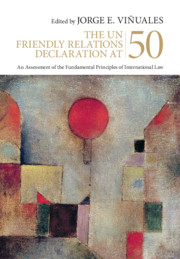 The UN Friendly Relations Declaration at 50
The UN Friendly Relations Declaration at 50 Book contents
- The UN Friendly Relations Declaration at 50
- The UN Friendly Relations Declaration at 50
- Copyright page
- Dedication
- Epigraph
- Contents
- Contributors
- Abbreviations
- Introduction
- 1 The System of the Friendly Relations Declaration
- 2 The Historical Origins and Setting of the Friendly Relations Declaration
- Part I The Principles of the Friendly Relations Declaration
- 3 The Prohibition of the Use of Force
- 4 Peaceful Settlement of International Disputes
- 5 The Duty Not to Intervene in Matters within Domestic Jurisdiction
- 6 Co-Operation
- 7 Self-Determination
- 8 Sovereign Equality
- 9 Good Faith
- Part II Fundamental Principles of International Law beyond the Friendly Relations Declaration
- Appendix The Friendly Relations Declaration (also available at www.un-documents.net/a25r2625.htm)
- Index
8 - Sovereign Equality
from Part I - The Principles of the Friendly Relations Declaration
Published online by Cambridge University Press: 21 September 2020
- The UN Friendly Relations Declaration at 50
- The UN Friendly Relations Declaration at 50
- Copyright page
- Dedication
- Epigraph
- Contents
- Contributors
- Abbreviations
- Introduction
- 1 The System of the Friendly Relations Declaration
- 2 The Historical Origins and Setting of the Friendly Relations Declaration
- Part I The Principles of the Friendly Relations Declaration
- 3 The Prohibition of the Use of Force
- 4 Peaceful Settlement of International Disputes
- 5 The Duty Not to Intervene in Matters within Domestic Jurisdiction
- 6 Co-Operation
- 7 Self-Determination
- 8 Sovereign Equality
- 9 Good Faith
- Part II Fundamental Principles of International Law beyond the Friendly Relations Declaration
- Appendix The Friendly Relations Declaration (also available at www.un-documents.net/a25r2625.htm)
- Index
Summary
Why did the legal principle of sovereign equality of States need a restatement in 1970? After all, it was not only expressly declared in the UN Charter (‘The Organization is based on the sovereign equality of its members’, Article 2(1)) but also deeply embedded in the conceptual structure of international law. One could say (and some have said) that the restatement was simply a redundancy. To be a ‘State’ was to possess sovereignty, and ‘sovereignty’ meant that one was not subordinated to another entity. All sovereigns would thus be equal in their non-subordination to each other. But whatever purists might say, the Friendly Relations Declaration was intended by its initiators neither as an exercise around the meaning or logic of the key concepts of the Charter nor as a formal celebration of their 25-year-old existence. It was instead part of the push by the decolonised world, the majority of the UN members that had not participated in the drafting of the Charter, to give its major provisions a meaning that would better include their objectives.
- Type
- Chapter
- Information
- The UN Friendly Relations Declaration at 50An Assessment of the Fundamental Principles of International Law, pp. 166 - 188Publisher: Cambridge University PressPrint publication year: 2020
- 1
- Cited by


